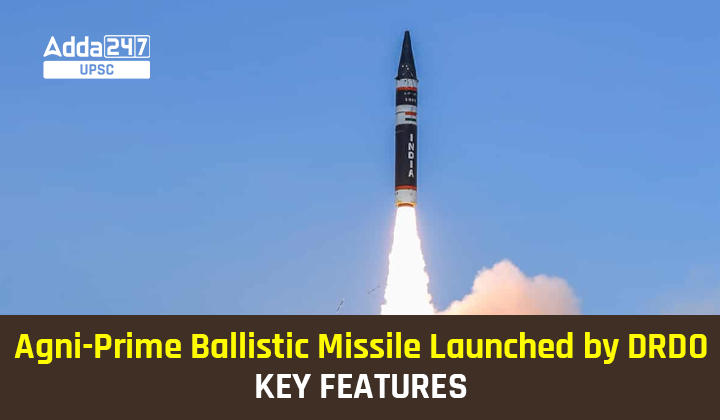Table of Contents
Agni-Prime Ballistic Missile: The Agni Prime missile has a striking range between 1,000 and 2,000 kilometers, making it a significant addition to India’s defense capabilities. Agni-Prime Ballistic Missile is also important for UPSC Prelims Exam and UPSC Mains Exam (GS Paper 3- Internal Security)
‘Agni Prime’ Ballistic Missile in News
The Defence Research and Development Organisation (DRDO) conducted a successful flight test of the ‘Agni Prime’ ballistic missile from Dr APJ Abdul Kalam Island, located off the coast of Odisha. The ‘Agni Prime’ Ballistic Missile test demonstrated the successful achievement of all the intended objectives.
Agni Prime Ballistic Missile
The Agni-Prime ballistic missile, a new-generation nuclear-capable weapon, was successfully tested by India. The missile was launched from the Abdul Kalam Island, situated off the coast of Odisha. With a striking range between 1,000 and 2,000 kilometers, the test showcased the missile’s capabilities.
- In a significant milestone, the tri-service Strategic Forces Command (SFC) of India successfully conducted the first pre-induction night launch of the Agni-Prime ballistic missile.
- The SFC, responsible for managing the nation’s nuclear arsenal, oversaw the operation. A defense ministry official confirmed that the test affirmed the system’s precision and dependability.
- The Agni-Prime missile is poised to gradually replace the Agni-I (700-km) missiles in the SFC’s arsenal.
- The Strategic Forces Command currently possesses several other ballistic missiles, including the Prithvi-II (350-km), Agni-II (2,000-km), Agni-III (3,000-km), and Agni-4 (4,000-km).
Agni Prime Ballistic Missile Features
Agni-Prime incorporates new propulsion systems and composite rocket motor casings as well as advanced navigation and guidance systems.
- Significantly, it is also a canister-launch system like the country’s first intercontinental ballistic missile (ICBM), the over 5,000-km Agni-V, which is now in the process of being inducted by the SFC.
- A canister-launch missile -with the warhead already mated with the missile- gives the armed forces the requisite operational flexibility to store it for long periods, swiftly transport it through rail or road when required, and fire it from wherever they want.
Agni Prime Ballistic Missile Significance
In addition to the Agni-V missile, the development of Agni-P will enhance India’s deterrence capabilities against both China and Pakistan.
- Agni-V already possesses the capability to strike targets across China, while Agni-P seems to have been specifically designed with Pakistan in mind.
- Recently, India achieved a significant milestone in its ballistic missile defense program by successfully conducting the maiden flight trial of an endoatmospheric interceptor missile from a ship located off the coast of Odisha in the Bay of Bengal.
- This test further demonstrates India’s commitment to strengthening its defensive capabilities against ballistic missile threats.
INS Mormugao, Indian Navy’s Indigenous Stealth Guided Missile Destroyer
| Follow US |
| UPSC Govt Jobs UPSC Current Affairs UPSC Judiciary PCS Download Adda 247 App here to get the latest updates |



 TSPSC Group 1 Question Paper 2024, Downl...
TSPSC Group 1 Question Paper 2024, Downl...
 TSPSC Group 1 Answer key 2024 Out, Downl...
TSPSC Group 1 Answer key 2024 Out, Downl...
 UPSC Prelims 2024 Question Paper, Downlo...
UPSC Prelims 2024 Question Paper, Downlo...
